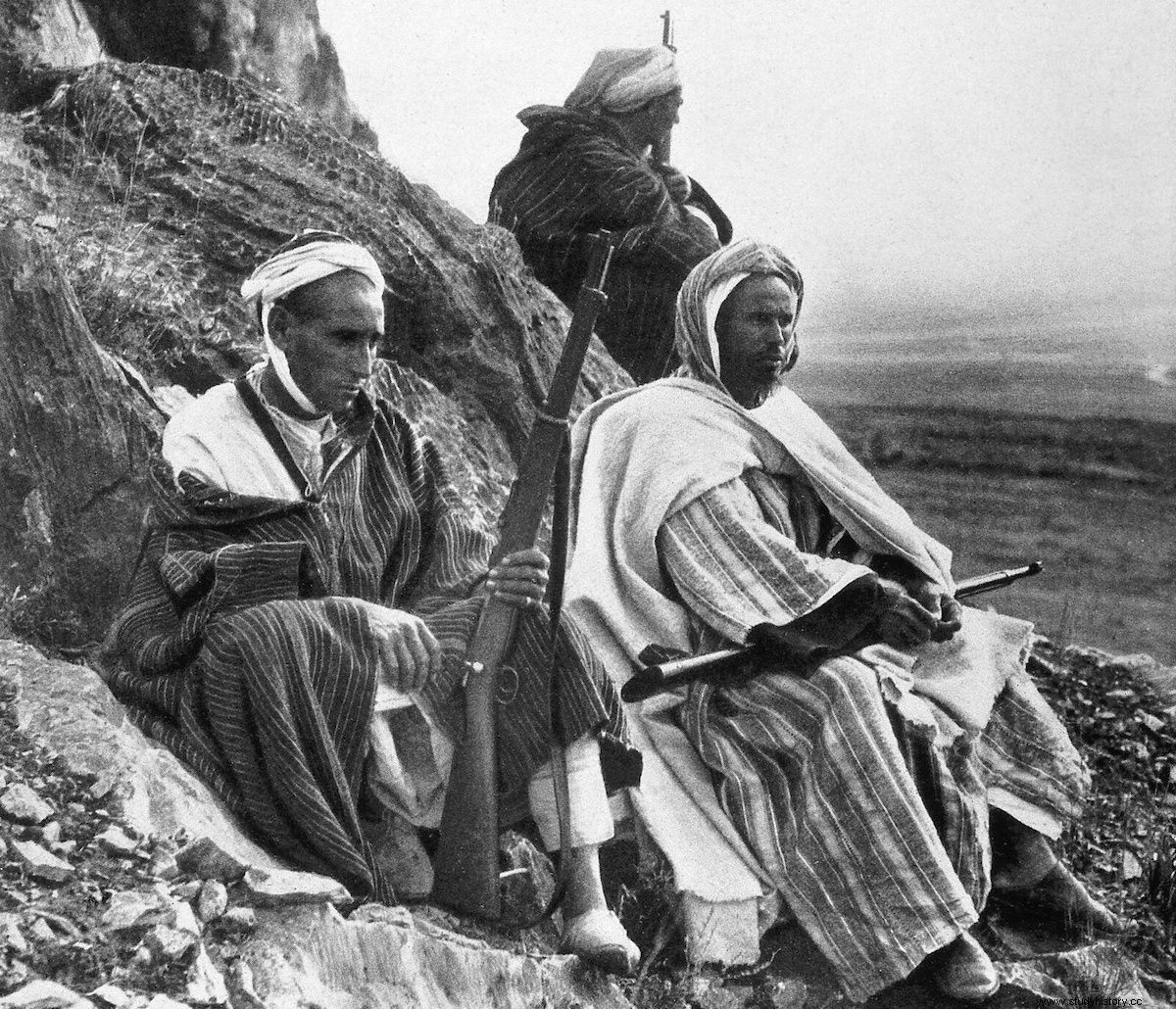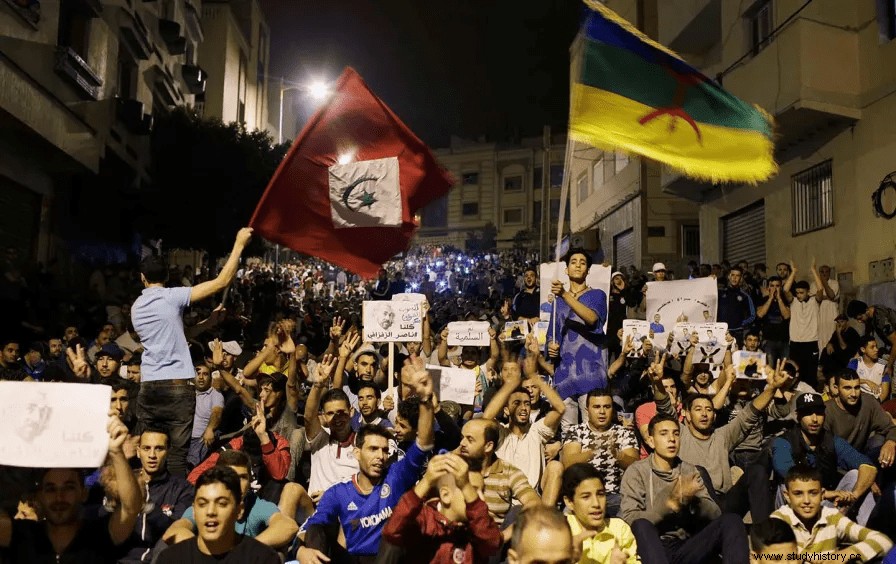
In 1956 Morocco gained independence , and it did not take long for the problem of integrating the northern zone into the rest of the country to arise. Linguistic unification meant that French replaced Spanish in school and administration. As there were no Francophone staff, they had to resort to Francophone administrators from other regions of the country, which caused obvious discomfort among the Rif people when they found themselves invaded by people from the former French Protectorate, who looked down on them as inferior beings. This situation led to a marginalization of the population of the northern area, and ended up generating deep resentment towards those who came from abroad, in general members of the Istiqlal Party.
Independence also exposed the enormous economic disparities between the two areas, and the inferiority of the Spanish Protectorate compared to the French in terms of development. The new authorities of independent Morocco not only did little to fill the gap, but behaved in the north as if on conquered ground. And that had been precisely in the north, where the Moroccan National Liberation Army , under the command of Abbas Messadi, had initiated a whole series of actions on October 2, 1955, directed against the puppet sultan Ben Arafa and the French authorities who had placed him on the throne, and aimed at restoring Mohamed V to the throne. .
Abbas Messadi's hostility to the Istiqlal Party and the obstacles it placed on his establishment in the north would lead to his physical elimination in circumstances that were not sufficiently elucidated. This murky event, which Mimoun Diouri did not hesitate to describe as "murder", would bring tail. When members of the Resistance decided to pay homage to Messadi as a martyr, a victim of Istiqlal, and transfer his remains from Fez, where he was buried, to the Rif, to give him a grandiose funeral there, precisely on October 2, 1958, the third anniversary of the beginning After the insurrection of the Liberation Army in the Rif, the funeral ceremony ended in a demonstration, brutally suppressed by the police who charged the demonstrators. We are thus witnessing the revolt of 1958-1959 .
The repression that was then waged on the region was brutal, savage, inhuman . 20,000 soldiers from the FAR (Royal Armed Forces) landed in the Rif, entering the region in three columns, one of which was led by General Ufkir. The planes that bombed the civilian population caused thousands of victims, while the crown prince, head of the FAR and future Hassan II, followed the progress of the operations from a helicopter, in which acts of extreme cruelty were carried out, such as opening the womb of pregnant women at the point of a bayonet. Many of the victims or their relatives denounced their suffering 45 years later in public hearing sessions within the framework of the Equity and Reconciliation Instance (IER), created by Mohamed VI in January 2004, poor consolation for so much pain. The events of the Rif of 1958 are still alive in the collective memory of the Rif people. The wounds are still open.
The Rif between Hasan II and Mohamed VI
Faced with Hassan II, who never visited the Rif and treated the Rif people as "enemies" who had to be crushed, his son and successor Mohamed VI from August 1999 it was proposed to rectify from the beginning of his reign, and already in October of the same year he visited the Rif, whose territory he traversed on a triumphal journey. Since then he has visited it frequently and even spends part of his vacations there, particularly on the coast of Al Hoceima to practice water skiing, a sport he is very fond of. Mohamed VI also proposed launching development plans for the northern zone, but these were limited to the western region, with the construction of the new port of Tangier (Tangier-Med), and to the eastern region, with the gigantic industrial and tourist development plans of Nador, while the central Rif, Alhucemas, was relegated. The construction of the motorway that runs along the coast from Tangier to the gates of Melilla undoubtedly represented great progress in the field of communications. In addition to this land route and the sea route, Alhucemas has an airport, which connects it by air with the main cities of Morocco and some European countries, particularly Spain, Belgium and the Netherlands, where important communities of rifians, but the interior of the Rif remains isolated, with lost customs that can only be accessed through goat trails or military tracks that date back to colonial times.

Poverty and underdevelopment persist in certain regions of the former Spanish Protectorate , where thousands and thousands of families subsist thanks to the cultivation of cannabis, smuggling with the cities of Ceuta and Melilla and remittances from Rif immigrants in European countries. The rifeños claim above all employment, health and education. In the field of health, there is an old demand for a cancer hospital in Al Hoceima, so that cancer patients do not have to travel to Rabat, and for a university or a campus dependent on the University of Fez or the University of Wow.
We have seen that, along with economic-social demands, the rifian identity claim appears more and more, symbolized by the flags. . This does not imply much less that the current Rif movement is mostly secessionist or separatist, nor was Abd el-Krim el Jatabi's movement in the twenties of the last century. What the people of Rif are asking for is that they not be treated as second-class citizens, but rather that their cultural and linguistic specificities be recognized, within a regime of broad autonomy similar to that of Catalonia or Euzkadi in Spain.
It is normal that the people of Rif claim today the figure of Abd el-Krim el Jatabi and feel proud of his legacy. Under Abd el-Krim, the Rif went from being an anonymous region of Morocco to occupying the foreground on the international scene. Abd el-Krim dignified the people of Rif, made them feel like active subjects in history.
